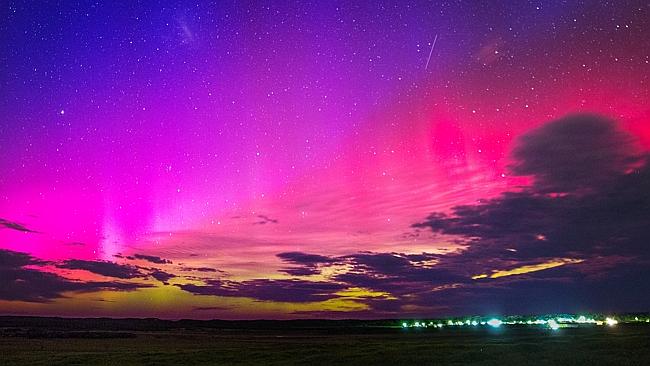Solar flare brings fiery night sky to much of southern Australia
THE sights are spectacular. Australia saw more of the night-time lights of Aurora Australis last night as solar storms continue to erupt from the Sun.

THE sights are spectacular. As solar storms erupt from the Sun today, Australia saw more of the night-time lights of Aurora Australis last night.
For keen skygazers, the Aurora was visible again after the Bureau of Meteorology’s Space Weather Services (SWS) yesterday issued an Aurora Alert.
It was possible to see the Aurora from Southern to Central Australian regions.
The best places in Australia to view it were tipped to be Tasmania and Victoria.
The incredibly beautiful event has already filled night skies in Australia with a burst of colours.
See the latest images below.
HOW AURORA AUSTRALIS WORKS
There’s a battle going on over our heads: Earth's ionosphere is fighting to repel an onslaught of raw energy shot at us from the Sun. The sights are spectacular.
Two strong solar storms have slammed into Earth in recent days, increasing the chances of fluctuations in the power grid and for GPS systems to go haywire.
There are also pushes shimmering polar auroras to places where more people can possibly see them — such as Sydney.
The shimmering, shifting light show is caused by electrically charged protons being diverted harmlessly by Earth's magnetic field. Those protons that get low enough — about 100km above the ground — can collide with the atoms of the upper atmosphere.
This generates the eerie glow.
The storms we’re currently experiencing have merged to create the most intense event since September 2005. And a third another has just erupted from the Sun — meaning the night-time lights of the Aurora Australis may continue for several more days.
WE’RE GOING TO EUROPA: Here’s why ... there may be life beneath the ice
If you want an indication of your chances of seeing an aurora, go to the Aurora Service forecast website. It gives notice of up to an hour as to when the lights will flare up.
The US National Oceanic and Atmospheric Administration says a potent blast of magnetic plasma shot out of the Sun on Sunday before hitting Earth.
It is a G4 (severe) geomagnetic storm that is travelling faster than usual. This solar storm is also having a stronger than usual effect due to the orientation of its magnetic field.
Tending towards south, NASA says fast-moving solar winds of this kind usually produce the most intense auroras.
NOAA space weather physicist Doug Biesecker said there are no reports of damage, but the electrical grid and GPS probably had current fluctuations that they could handle.
He said the storm could last a day or longer.
Earth’s upper atmosphere had already been charged at the time it struck: By a different solar radiation storm.
An earlier S3 (representing strong) radiation event has energised Earth’s polar regions with charged particles.
Combined, the solar radiation and geomagnetic storms are forcing the auroras lower and further towards the equator.
More may be on the way.
A mid-level solar flare was spotted earlier Tuesday erupting from the Sun.
It has been classified as an M6.6-strength flare. It’s about one-tenth the strength of the most powerful flares to have been recorded.
The plasma — otherwise known as a Coronal Mass Ejection (CME) — associated with this flare is expected to arrive over Earth within the next two to three days.



